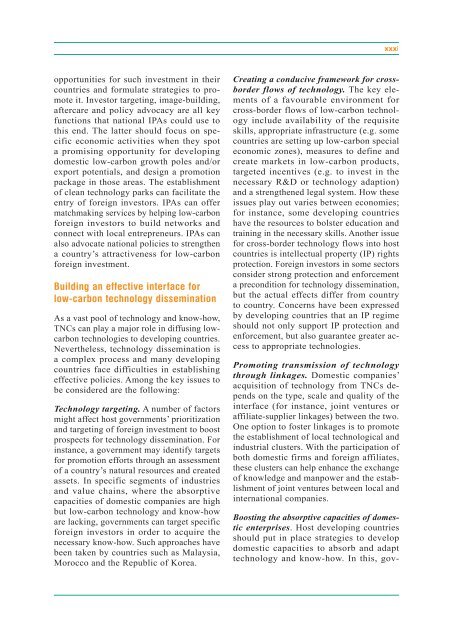UN World Investment Report 2010 - Office of Trade Negotiations
UN World Investment Report 2010 - Office of Trade Negotiations
UN World Investment Report 2010 - Office of Trade Negotiations
Create successful ePaper yourself
Turn your PDF publications into a flip-book with our unique Google optimized e-Paper software.
opportunities for such investment in their<br />
countries and formulate strategies to promote<br />
it. Investor targeting, image-building,<br />
aftercare and policy advocacy are all key<br />
functions that national IPAs could use to<br />
this end. The latter should focus on specific<br />
economic activities when they spot<br />
a promising opportunity for developing<br />
domestic low-carbon growth poles and/or<br />
export potentials, and design a promotion<br />
package in those areas. The establishment<br />
<strong>of</strong> clean technology parks can facilitate the<br />
entry <strong>of</strong> foreign investors. IPAs can <strong>of</strong>fer<br />
matchmaking services by helping low-carbon<br />
foreign investors to build networks and<br />
connect with local entrepreneurs. IPAs can<br />
also advocate national policies to strengthen<br />
a country’s attractiveness for low-carbon<br />
foreign investment.<br />
Building an effective interface for<br />
low-carbon technology dissemination<br />
As a vast pool <strong>of</strong> technology and know-how,<br />
TNCs can play a major role in diffusing lowcarbon<br />
technologies to developing countries.<br />
Nevertheless, technology dissemination is<br />
a complex process and many developing<br />
countries face difficulties in establishing<br />
effective policies. Among the key issues to<br />
be considered are the following:<br />
Technology targeting. A number <strong>of</strong> factors<br />
might affect host governments’ prioritization<br />
and targeting <strong>of</strong> foreign investment to boost<br />
prospects for technology dissemination. For<br />
instance, a government may identify targets<br />
for promotion efforts through an assessment<br />
<strong>of</strong> a country’s natural resources and created<br />
assets. In specific segments <strong>of</strong> industries<br />
and value chains, where the absorptive<br />
capacities <strong>of</strong> domestic companies are high<br />
but low-carbon technology and know-how<br />
are lacking, governments can target specific<br />
foreign investors in order to acquire the<br />
necessary know-how. Such approaches have<br />
been taken by countries such as Malaysia,<br />
Morocco and the Republic <strong>of</strong> Korea.<br />
xxxi<br />
Creating a conducive framework for crossborder<br />
flows <strong>of</strong> technology. The key elements<br />
<strong>of</strong> a favourable environment for<br />
cross-border flows <strong>of</strong> low-carbon technology<br />
include availability <strong>of</strong> the requisite<br />
skills, appropriate infrastructure (e.g. some<br />
countries are setting up low-carbon special<br />
economic zones), measures to define and<br />
create markets in low-carbon products,<br />
targeted incentives (e.g. to invest in the<br />
necessary R&D or technology adaption)<br />
and a strengthened legal system. How these<br />
issues play out varies between economies;<br />
for instance, some developing countries<br />
have the resources to bolster education and<br />
training in the necessary skills. Another issue<br />
for cross-border technology flows into host<br />
countries is intellectual property (IP) rights<br />
protection. Foreign investors in some sectors<br />
consider strong protection and enforcement<br />
a precondition for technology dissemination,<br />
but the actual effects differ from country<br />
to country. Concerns have been expressed<br />
by developing countries that an IP regime<br />
should not only support IP protection and<br />
enforcement, but also guarantee greater access<br />
to appropriate technologies.<br />
Promoting transmission <strong>of</strong> technology<br />
through linkages. Domestic companies’<br />
acquisition <strong>of</strong> technology from TNCs depends<br />
on the type, scale and quality <strong>of</strong> the<br />
interface (for instance, joint ventures or<br />
affiliate-supplier linkages) between the two.<br />
One option to foster linkages is to promote<br />
the establishment <strong>of</strong> local technological and<br />
industrial clusters. With the participation <strong>of</strong><br />
both domestic firms and foreign affiliates,<br />
these clusters can help enhance the exchange<br />
<strong>of</strong> knowledge and manpower and the establishment<br />
<strong>of</strong> joint ventures between local and<br />
international companies.<br />
Boosting the absorptive capacities <strong>of</strong> domestic<br />
enterprises. Host developing countries<br />
should put in place strategies to develop<br />
domestic capacities to absorb and adapt<br />
technology and know-how. In this, gov-

















